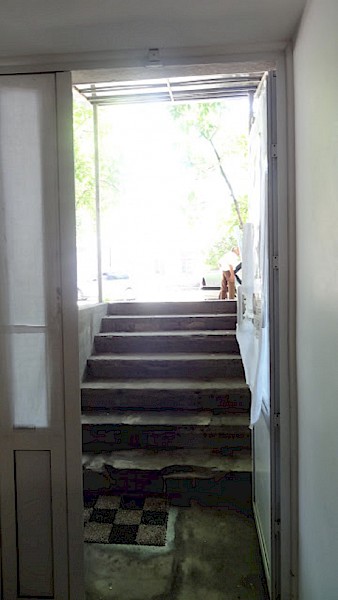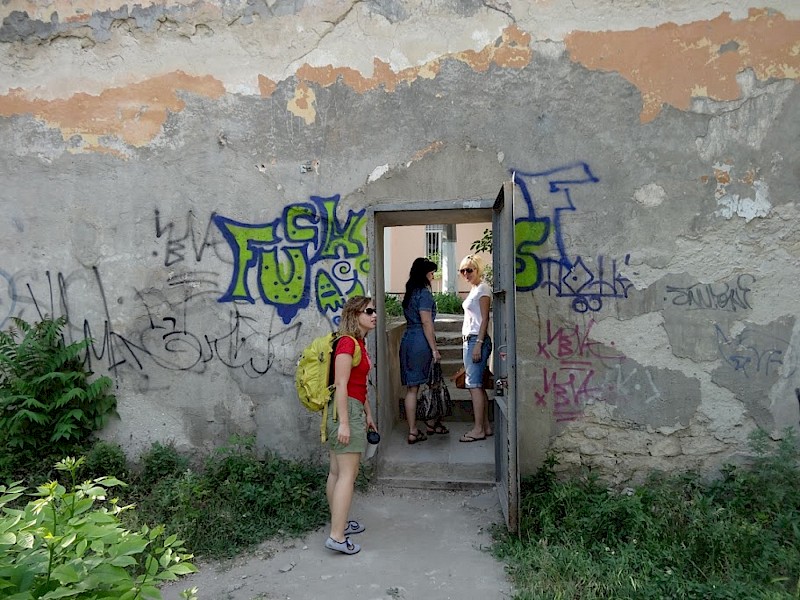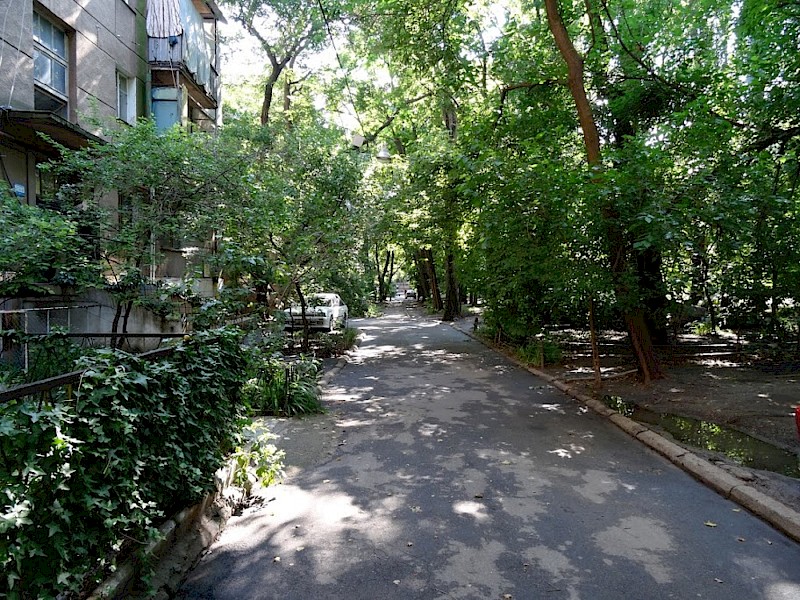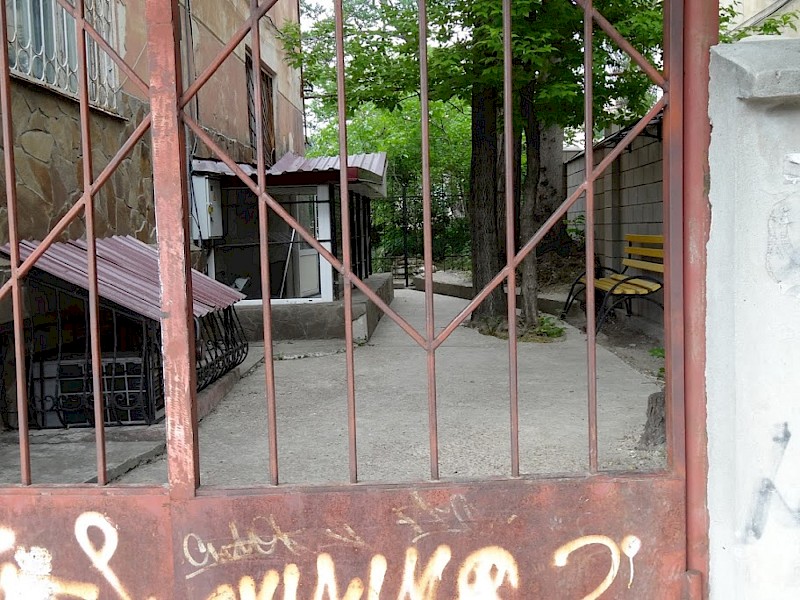HIV prevention, precarity, and fragmented landscapes of service provision in Ukraine
—
This essay uses photographs to explore the multiple forms of precarity that contour the ‘therapeutic landscapes’ of HIV prevention work in Ukraine. The images we present were taken using smartphones and digital cameras, as part of a five-year research project focused on how grassroots agencies developed and implemented evidence-based HIV prevention programs in eight Ukrainian cities from 2012 to 2017. The initial purpose of the photographs, which were taken at the beginning of the study, was to document the look and ‘feel’ of the various HIV service agencies we frequented for members of our study team who were not on site. Only later, after conducting intensive fieldwork and making multiple visits to these sites to interview agency staff, did we come to view these photos as poignant representations of ‘precarious’ therapeutic landscapes.
Precarity refers to insecurity in material, existential, and social life (Allison 2012, 2013). It is inhabited by particular people in particular moments. Photographs, we argue, reveal the emplaced nature of precarity and its multiple forms, in ways that text cannot (Stewart 2012). A photograph captures a social and physical space, rendering it visible, ponderable, and partially knowable. Yet, the meaning of a photograph is never fixed, and is open to multiple, alternate interpretations. Here, we argue that photographs have the power to illuminate how therapeutic landscapes – in this case, those of HIV prevention work – may create spaces of solidarity, empathy, and resilience, at the same time as they produce precarity in the form of vulnerabilities, shadows, and ‘gray areas’ (Stafford 2003). Specifically, photographs can reveal the multiple forms of precarity experienced not only by ‘clients’ of HIV service agencies (such as people who use drugs and commercial sex workers) but also agency staff (such as outreach workers). Agency clients and staff inhabited, transversed, and transformed places and encounters imbued with symbolic, material, and political dimensions, and forms of inclusion and exclusion (Gesler 1992, 743). Our photographs reveal some of the contradictions and vulnerabilities of place experienced by these individuals, who were generally precarious subjects in environments hostile to them or their work. In pondering precarity’s multiple and emplaced forms, this photo essay cuts against the bucolic notion of therapeutic landscapes that presumes an uncomplicated ‘healing power’ of space (Bell et al. 2015).
In the context of entrenched stigma and discrimination towards at-risk populations such as people who use drugs and commercial sex workers, HIV-prevention efforts in Ukraine have been driven underground. Many HIV service agencies were located unobtrusively in basements with minimal signage (photograph 1). In these hidden spaces, agency staff struggled to create a safe, supportive environment for clients, and provide them with harm-reduction supplies (such as sterile syringes and condoms) and knowledge about safer injecting that would allow clients to better protect themselves from HIV and other diseases. Yet, temptations and risks for clients were immediate. As a space where drug users gathered and harm-reduction services were provided, agencies attracted drug dealers and invited police surveillance, leading to incidents of violence, bribery, and the destruction of harm-reduction supplies by police (Booth et al. 2013). Agency staff navigated their own emplaced precarity in these spaces. Their sense of success in helping people was fragile since, right across the street from the agency, they often saw clients approaching drug dealers or being hassled by police as soon as they left. As staff ushered clients up the stairs like those pictured in photograph 1, clients emerged to new possibilities and new risks.
In Mykolaiv a ‘black’ (secret), unlabeled entrance to the regional AIDS centre allowed, in theory, for ostensibly anonymous entry. In photograph 2, the graffiti reads, ‘Fuck AIDS’, which ‘outs’ this location as the back door to an AIDS centre. In addition to providing HIV tests and treatment, AIDS centres also served as recruitment sites for medical and behavioral research. While participation in these studies could be a welcome source of income for vulnerable populations through incentive payments and research honoraria, clients’ financial and biological precarity resulted in a situation in which they were simultaneously patients and potential research subjects (Knight 2015). If clients inhabited the therapeutic landscape of the AIDS centre as ‘needy’ and vulnerable patient-research subjects, agency staff occupied these spaces differently. Staff accompanied clients for testing and treatment and, facing their own financial precarity, were also contracted (paid extra) to administer research surveys to these same clients. As advocates and ‘experts’, staff were positioned hierarchically above patient-clients-research subjects. However, within the highly medicalized realm of the AIDS centres, their authority was often questioned by medical personnel and centre administrators. HIV service agency staff inhabited a liminal status, in which they were not patients but not quite professionals.
People living with and ‘at risk’ of contracting HIV/AIDS in Ukraine face significant stigma, and neighbors and passersby were often concerned or even fearful about agencies’ work with these individuals and populations. By keeping the entrances to agencies and centres clean and welcoming, staff attempted to create familiar therapeutic landscapes that appealed to both clients and passersby (photograph 3). As a staff member described during a 2013 interview: ‘We keep things clean; we take care of the grounds. We even pick up the cigarette butts, and tell clients to do the same’. A focus on ‘clean appearances’ revealed the symbolic forms of precarity experienced by at-risk or ‘undesirable’ populations and the staff who advocate for them. Insisting that the facilities and surrounding area be kept clean also powerfully countered stigmatizing depictions of clients as diseased, dirty, and irresponsible.
Agencies utilized ‘mobile clinics’ for outreach, needle exchange, HIV and STD testing, and providing care to clients throughout the city (photograph 4). Reflecting agency clients’ and staff workers’ precarity at the level of the social body (Scheper-Hughes and Lock 1987), mobile clinics often had to be parked out of sight, in obscure alleyways (Spicer et al. 2011). The mobile clinic in photograph 4 was donated by the Alliance for Public Health in Ukraine through funding from the Global Fund for HIV/AIDS and Tuberculosis Response that will largely dry up after 2017, reflecting precarity at the level of the political body (ibid.). In general, the Ukrainian state’s failure to fund HIV-prevention initiatives meant that the agencies’ existence was under constant threat.
HIV service agencies were open only during working hours. After hours, buildings were locked up (photograph 5), and services were delivered through mobile clinics or late-night pharmacies, resulting in an ever-changing map of services in a given city. And there was a constant threat that these daily closures could be made more permanent. After the annexation by Russia of the Crimean peninsula in 2014, some of the services provided by HIV service agencies, like opioid agonist treatment, are now illegal; others, like syringe distribution, are not supported. As political, economic, and social climates shift, the therapeutic landscapes previously nurtured in many of these spaces can no longer be tended, exposing the precarity of both the agency staff and clients, who are left without salaries and harm-reduction supplies.
In conclusion, these images complicate bucolic notions of therapeutic landscapes, evoking the multiple forms of precarity encountered by actors in ‘public health’ settings of HIV prevention in Ukraine. Agency clients and staff experienced different forms of precarity at the levels of the individual, social, and political body. Precarity was simultaneously symbolic (the need to keep these spaces ‘hidden’ or ‘clean’), embodied (lending one’s body for research in exchange for money, being deprived of opioid agonist treatment), and political (the state’s refusal to fund HIV prevention). Using photographs to explore therapeutic landscapes reveals how precarity and its many forms are profoundly emplaced: a shadow here, a burst of light there, a space of emptiness, a place of possibility.
About the authors
Sarah D. Phillips is Professor of Anthropology and Director of the Russian and East European Institute at Indiana University. She received her PhD in Anthropology at the University of Illinois at Urbana-Champaign in 2002. Her research specialties are in gender, health, disability, and social movements in the former Soviet Union, especially Ukraine. Phillips teaches courses on medical anthropology, the anthropology of Russia and East Europe, and postsocialist gender formations.
Jill Owczarzak is Assistant Professor in the Department of Health, Behavior and Society at the Johns Hopkins School of Public Health. Prior to joining the JHSPH faculty in 2013, she was an Assistant Professor at the Center for AIDS Intervention Research at the Medical College of Wisconsin. She received her PhD in Anthropology from the University of Kentucky in 2007. Her research focuses on how frontline service providers use evidence-based programs in their public health practice, and how models of health intervention and the practices they entail address questions of socioeconomic, gender, and other forms of inequality. She works in Ukraine and the United States.
References
Allison, Anne. 2012. ‘Ordinary Refugees: Social Precarity and Soul in 21st Century Japan’. Anthropological Quarterly 85: 345–70. https://doi.org/10.1353/anq.2012.0027.
Allison, Anne. 2013. Precarious Japan. Durham, NC: Duke University Press.
Bell, Sarah, Cassandra Phoenix, Rebecca Lovell, and Benedict Wheeler. 2015. ‘Seeking Everyday Wellbeing: The Coast as Therapeutic Landscape’. Social Science and Medicine 142: 56–67. https://doi.org/10.1016/j.socscimed.2015.08.011.
Booth, Robert E., Sergey Dvoryak, Min Sung-Joon, et al. 2013. ‘Law Enforcement Practices Associated with HIV Infection among Injection Drug Users in Odessa, Ukraine’. AIDS & Behavior 17: 2604–14. https://doi.org/10.1007/s10461-013-0500-6.
Gesler, Wilbert M. 2009. ‘Therapeutic Landscapes: Medical Issues in Light of the New Cultural Geography’. Social Science & Medicine 34: 735–46. https://doi.org/10.1016/0277-9536(92)90360-3.
Knight, Kelly Ray. 2015. addicted.pregnant.poor. Durham, NC: Duke University Press.
Scheper-Hughes, Nancy, and Margaret Lock. 1987. ‘The Mindful Body: A Prolegomenon to Future Work in Medical Anthropology’. Medical Anthropology Quarterly 1: 6–41. https://doi.org/10.1525/maq.1987.1.1.02a00020.
Spicer, Neil, Daryna Bogdan, Ruairi Brugha, Andrew Harmer, Gulgun Murzalieva, and Tetiana Semigina. 2011. ‘“It’s Risky to Walk in the City with Syringes”: Understanding Access to HIV/AIDS Services for Injection Drug Users in the Former Soviet Union Countries of Ukraine and Kyrgyzstan’. Global Health 7: 1–15. https://doi.org/10.1186/1744-8603-7-22.
Stafford, Philip J., ed. 2003. Gray Areas: Encounters with Nursing Home Culture. Santa Fe, NM: School for Advanced Research Press.
Stewart, Kathleen. 2012. ‘Precarity’s Forms’. Cultural Anthropology 27: 518–25. https://doi.org/10.1111/j.1548-1360.2012.01157.x.




